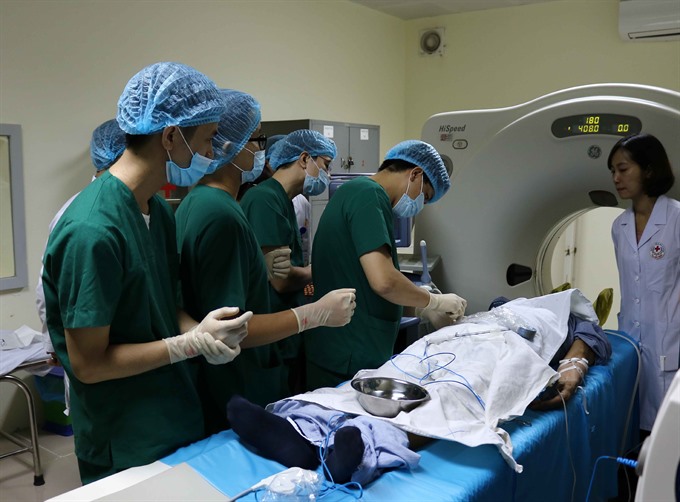 Society
Society

" />Significant progress has been achieved in understanding the molecular basis of cancer over the past 30 years, leading to new interventions suited to each patient, Professor Nguyễn Chấn Hùng, chairman of the Việt Nam Cancer Association, has said.
 |
| Doctors at Bắc Ninh General Hospital treat a patient for liver cancer. Chairman of the Việt Nam Cancer Association said significant progress has been achieved in understanding the molecular basis of cancer. — VNA/VNS Photo Thanh Thương |
HCM CITY — Significant progress has been achieved in understanding the molecular basis of cancer over the past 30 years, leading to new interventions suited to each patient, Professor Nguyễn Chấn Hùng, chairman of the Việt Nam Cancer Association, has said.
"The accumulation of this basic knowledge has established that cancer is a variety of distinct diseases and that defective genes cause these diseases," Hùng said at a two-day oncology conference that ended on Thursday in HCM City.
The gene defects are diverse in nature and can involve either loss or gain of gene functions, he said, adding that this knowledge has been exploited recently to develop strategies for cancer prevention and treatment.
Dr Lê Hoàng Minh, head of the city’s Oncology Hospital, said the country had seen an increase of cancer incidence. The hospital has admitted 27,000-28,000 new cancer patients every year, he said.
According to Thống Nhất Hospital’s oncology ward in Tân Bình District, 2,754 cancer patients have been treated there since 2012.
Of these, the proportion of patients with colorectal cancer was the highest, with 26.37 per cent.
Lung cancer ranked second with 22 per cent, followed by cancer of the stomach, liver, breast and non-Hodgkins lymphoma.
The city’s cancer statistics in 2014 showed that the ratio of cancer in men was 172 per 100,000 and 138.7 per 100,000 for women.
The five most common cancers in men were lung, liver, colon and rectum, stomach and larynx.
Cancer of the breast, cervix uteri, colon and rectum, lung and thyroid were the most common among women.
The diagnosis of most common cancers in both men and women increased rapidly from the age of 40.
A survey of 27,092 cancer patients at three oncology hospitals in Hà Nội conducted in 2014 showed that 63 per cent were diagnosed and treated at a late stage.
Of these, patients with late-stage liver cancer accounted for the highest proportion, followed by gastric and bronchopulmonary cancers.
Network of oncology prevention
Tăng Chí Thượng, deputy head of the city’s Department of Health, said that a network of health facilities had been set up throughout the country to prevent and treat cancer.
In the city, the network is available at grassroots health centres and specialised hospitals.
It has helped detect nearly 25,000 new cancer patients in the city between 2011 and 2015.
Many doctors have been trained by experts from the city’s Oncology Hospital and the Việt Nam Cancer Association, Thượng said.
At least 100 new medical school graduates have been sent to the Oncology Hospital for training and will work at its new branch now under construction.
The network has also sped up research to solve shortcomings in treatment, he said.
Via the network, doctors are trained in palliative care which has helped improve the quality of life for patients who are critically ill.
According to a study of the Oncology Hospital’s doctors conducted from June 2013 to September 2014, palliative care focuses on making the patient comfortable and controlling pain.
The conference also discussed advanced technologies used in treatment by oncology hospitals in the country.
Endoscopic thyroidectomy via a unilateral axillo-breast approach, for instance, is used for treating thyroid goiters at the city’s Oncology Hospital.
A study of this technique conducted by the hospital’s doctors in 2014 showed that it was a feasible and safe procedure with good cosmetic results.
Moreover, advanced radiotherapies such as intensity-modulated radiotherapy and stereotactic body radiation therapy are used at 108 Hospital, Huế Central Hospital and the city’s Oncology Hospital. —VNS




